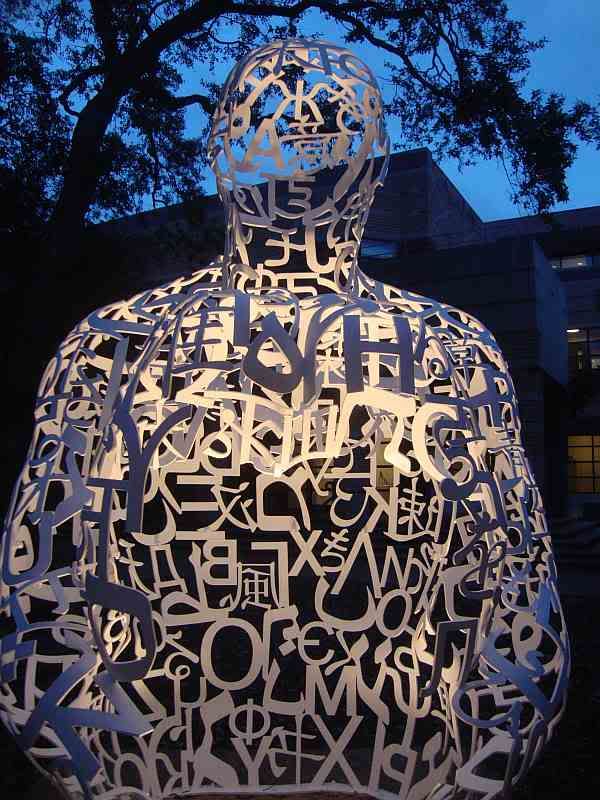
Jaume Plensa, Mirror, painted metal, 10 feet high, 2012
When I read about and saw photos of Mirror by Jaume Plensa, which has just been installed in the oak grove between Herring Hall and the Brochstein pavillion at Rice University, I instantly decided I hated it. And I still sort of hate it. Mirror consists of two generic figures (perhaps inspired by the figure on the pedestrian crossing sign?) facing each other, knees up with their arms around them, having some kind of intellectual dialogue, represented by their skins which consist of letters from various alphabets. You know, like two students at a university symbolizing dialogue and learning and stuff!

Jaume Plensa, Mirror, painted metal, 10 feet high, 2012
They seem similar to another Plensa sculpture in Houston, Tolerance, a grouping of a bunch of kneeling super-generic figures with skins made out of words in many languages. And they are all getting along with one another! Because they are tolerant! So uplifting!

Jaume Plensa, Mirror, painted metal, 10 feet high, 2012
I hate Plansa's sculptures. They are simultaneously heavy-handed and vague. They say, "Here's an uplifting message that you can look at or not, I don't care." I realize that the generic nature of the figures is meant to give them a kind of universality, but it instead projects blandness. No one can disagree with the intent behind these pieces, but no one can be moved by them.

Jaume Plensa, Mirror, painted metal, 10 feet high, 2012
But that's me. Everyone except for Kelly Klassmeyer seems to love Jaume Plensa's art. When they go up in public places, his sculptures are always popular. How is it that work that seems so obviously meretricious, that seems to pander so damn hard, is so popular?

Jaume Plensa, Mirror (seen from inside), painted metal, 10 feet high, 2012
I found the answer when I went to photograph Mirror at twilight. In the evening, this sculpture looks undeniably cool. I saw it and suddenly found myself questioning my earlier dismissal. The white painted metal shapes, lit from the inside by lights embedded into the ground, have a ghostly presence among the oaks outside Herring Hall.

Jaume Plensa, Mirror (seen from inside), painted metal, 10 feet high, 2012
And Plensa doesn't rely solely on how cool it looks at night--he includes the additional crowd-pleasing feature of interactivity. You can crawl inside these figures and look out through the cage of alphabets.
Curse you Jaume Plensa--you sucked me in! I still think the basic idea and presentation of Mirror is ridiculous. But Plensa made a pair of sculptures that look pretty neat--at night. On balance, I would rather that Rice had installed something different. But I'm willing to see some value in Mirror.




I find Plensa's work lacking in technical and conceptual interest. Mass produced computer cut letters collaged over a form and such an obvious and ultimately text based concept cannot be made up for by scale or putting a light inside. Rice is doing the typical institutional thing- playing it safe with figurative, accessible, unambiguous public art. Gee, I can't wait for every outdoor sculpture in Houston to be a Plensa.
ReplyDeleteTo Rice's credit, they have a large Michael Heizer and a nice Aurora Robson. But yeah, this seems like feel-good kitsch.
ReplyDelete